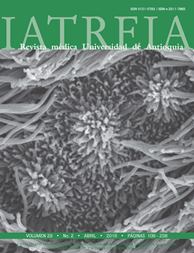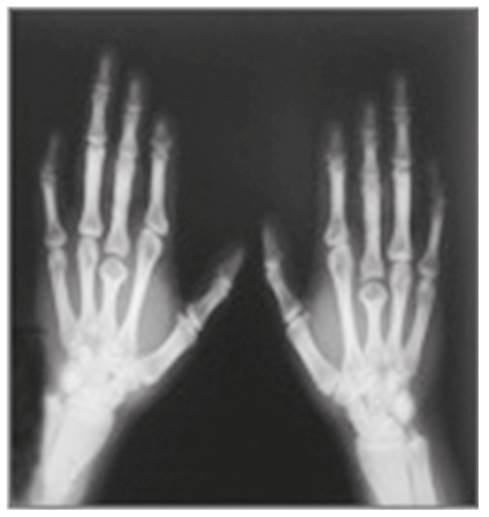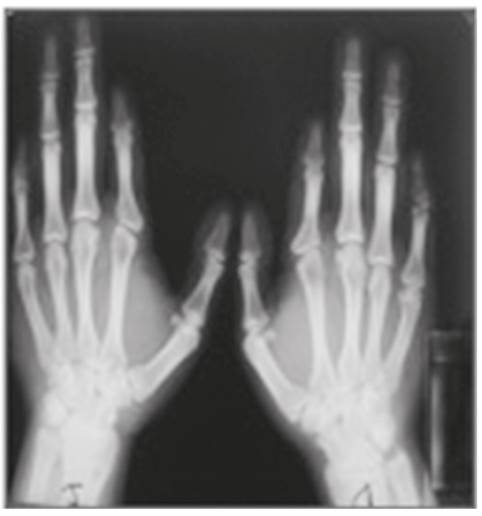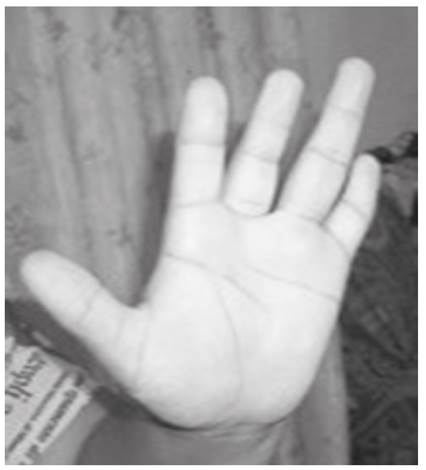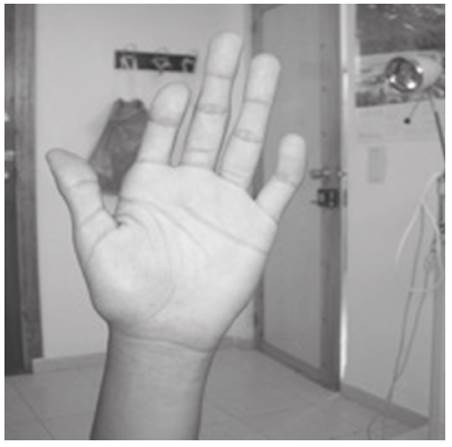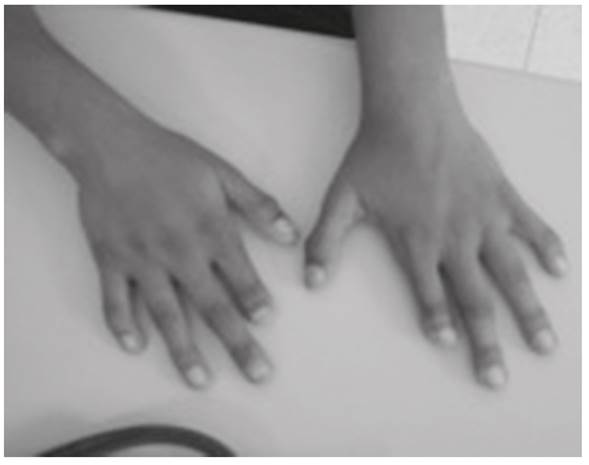Estudio de la braquidactilia en población gitana: descripción de un caso familiar
DOI:
https://doi.org/10.17533/udea.iatreia.v29n2a10Palabras clave:
agentes comunitarios de salud, braquidactilia, consanguinidad, grupos étnicos, salud comunitariaResumen
La braquidactilia constituye una malformación genética heredable con carácter autosómico dominante o recesivo. En este artículo se describe el caso de una familia gitana que presenta braquidactlia congénita. El estudio se hizo en el Distrito Sanitario de Guadix en Granada. Los sujetos de estudio fueron cuatro hermanos (dos hombres y dos mujeres) integrantes de la misma unidad familiar y pertenecientes a la comunidad gitana. Se recogieron datos sociodemográficos y genéticos. Los sujetos presentan la manifestación de braquidactilia expresada fenotípicamente con alguna variabilidad entre ellos. Los datos radiológicos evidencian que corresponden a la braquidactilia tipo A4. Uno de ellos presenta una mezcla de A4 con E, o quizás se trate de una nueva variedad no clasificada. Todos presentan anomalías similares en los pies. Además, presentan obesidad, dislipidemia y diversos grados de consanguinidad.
Descargas
Citas
(1.) Morar B, Gresham D, Angelicheva D, Tournev I, Gooding R, Guergueltcheva V, et al. Mutation history of the roma/gypsies. Am J Hum Genet. 2004 Oct;75(4):596-609.
(2.) Robson AG, Webster AR, Michaelides M, Downes SM, Cowing JA, Hunt DM, et al. “Cone dystrophy with supernormal rod electroretinogram”: a comprehensive genotype/phenotype study including fundus autofluorescence and extensive electrophysiology. Retina. 2010 Jan;30(1):51-62. DOI 10.1097/IAE.0b013e3181bfe24e.
(3.) Adzhubei IA, Schmidt S, Peshkin L, Ramensky VE, Gerasimova A, Bork P, et al. A method and server for predicting damaging missense mutations. Nat Methods. 2010 Apr;7(4):248-9. DOI 10.1038/nmeth0410-248.
(4.) Chamova T, Florez L, Guergueltcheva V, Raycheva M, Kaneva R, Lochmüller H, et al. ANO10 c.1150_1151de is a founder mutation causing autosomal recessive cerebellar ataxia in Roma/Gypsies. J Neurol. 2012 May;259(5):906-11. DOI 10.1007/s00415-011-6276-6.
(5.) Holtzman NA, Marteau TM. Will genetics revolutionize medicine? N Engl J Med. 2000 Jul;343(2):141-4.
(6.) Bottorff JL, Blaine S, Carroll JC, Esplen MJ, Evans J, Nicolson Klimek ML, et al. The educational needs and professional roles of Canadian physicians and nurses regarding genetic testing and adult onset hereditary disease. Community Genet. 2005;8(2):80-7.
(7.) Gamella JF, Carrasco-Muñoz EM, Núñez Negrillo AM. Oculocutaneous albinism and consanguineous marriage among Spanish Gitanos or Calé--a study of 83 cases. Coll Antropol. 2013 Sep;37(3):723-34.
(8.) Dathe K, Kjaer KW, Brehm A, Meinecke P, Nürnberg P, Neto JC, et al. Duplications involving a conserved regulatory element downstream of BMP2 are associated with brachydactyly type A2. Am J Hum Genet. 2009 Apr;84(4):483-92. DOI 10.1016/j.ajhg.2009.03.001.
(9.) Lehmann K, Seemann P, Silan F, Goecke TO, Irgang S, Kjaer KW, et al. A new subtype of brachydactyly type B caused by point mutations in the bone morphogenetic protein antagonist NOGGIN. Am J Hum Genet. 2007 Aug;81(2):388-96.
(10.) Demirhan O, Türkmen S, Schwabe GC, Soyupak S, Akgül E, Tastemir D, et al. A homozygous BMPR1B mutation causes a new subtype of acromesomelic chondrodysplasia with genital anomalies. J Med Genet. 2005 Apr;42(4):314-7.
(11.) Plöger F, Seemann P, Schmidt-von Kegler M, Lehmann K, Seidel J, Kjaer KW, et al. Brachydactyly type A2 associated with a defect in proGDF5 processing. Hum Mol Genet. 2008 May;17(9):1222-33. DOI 10.1093/hmg/ddn012.
(12.) Kjaer KW, Eiberg H, Hansen L, van der Hagen CB, Rosendahl K, Tommerup N, et al. A mutation in the receptor binding site of GDF5 causes Mohr-Wriedt brachydactyly type A2. J Med Genet. 2006 Mar;43(3):225-31.
(13.) Temtamy SA, Aglan MS. Brachydactyly. Orphanet J Rare Dis. 2008 Jun;3:15. DOI 10.1186/1750-1172-3-15.
(14.) Gracia JN, Ruffin J. Partnership, research, and leadership to advance health equity and eliminate health disparities. Am J Public Health. 2014 Sep;104 Suppl 4:S520-1. DOI 10.2105/AJPH.2014.302201.
(15.) Clark C. Defining ethnicity in a cultural and sociolegal context: the case of Scottish Gypsy-Travellers. Scottish Affairs. 2006;54:39-67.
(16.) Karlsen S, Nazroo JY. Agency and structure: the impact of ethnic identity and racismo on the health of ethnic minority people. Sociol Health Ill. 2002;24(1):1-20.
(17.) La Parra D, Gil-González D, Jiménez A. Los procesos de exclusión social y la salud del pueblo gitano en España. Gac Sanit. 2013 Sep-Oct;27(5):385-6. DOI 10.1016/j.gaceta.2013.05.001.
(18.) Wade C, Brinas I, Welfare M, Wicking C, Farlie PG. Twist2 contributes to termination of limb bud outgrowth and patterning through direct regulation of Grem1. Dev Biol. 2012 Oct;370(1):145-53. DOI 10.1016/j.ydbio.2012.07.025.
(19.) Cervantes-Barragán DE, Villarroel CE, Medrano-Hernández A, Durán-McKinster C, Bosch-Canto V, Del-Castillo V, et al. Setleis syndrome in Mexican-Nahua sibs due to a homozygous TWIST2 frameshift mutation and partial expression in heterozygotes: review of the focal facial dermal dysplasias and subtype reclassification. J Med Genet. 2011 Oct;48(10):716-20. DOI 10.1136/jmedgenet-2011-100251.
(20.) Chaabouni M, Le Merrer M, Raoul O, Prieur M, de Blois MC, Philippe A, et al. Molecular cytogenetic analysis of five 2q37 deletions: refining the brachydactyly candidate region. Eur J Med Genet. 2006 May-Jun;49(3):255-63.
(21.) Foster MW, Sharp RR. Race, ethnicity, and genomics: social classifications as proxies of biological heterogeneity. Genome Res. 2002 Jun;12(6):844-50.
(22.) Flodgren G, Parmelli E, Doumit G, Gattellari M, O’Brien MA, Grimshaw J, et al. Local opinion leaders: effects on professional practice and health care outcomes. Cochrane Database Syst Rev. 2011 Aug;(8):CD000125. DOI 10.1002/14651858.CD000125.pub4.
(23.) Bergeron DA, Bourgault P, Gallagher F. [Nursing activities in family medicine groups for patients with chronic pain]. Pain Res Manag. 2015 Mar-Apr;20(2):101-6. French.
(24.) Conn VS, Enriquez M, Ruppar TM, Chan KC. Cultural relevance in medication adherence interventions with underrepresented adults: systematic review and meta-analysis of outcomes. Prev Med. 2014 Dec;69:239-47. DOI 10.1016/j.ypmed.2014.10.021.
(25.) Conway SM. Health education: leading the way to a healthy future. NASN Sch Nurse. 2015 Jan;30(1):10-2.
(26.) Speroni KG. School nurse facilitated programs for families living fit. NASN Sch Nurse. 2014 May;29(3):140-4.
(27.) Bedford S, Jones E. Should lifestyle choices affect access to transplant? Nurs Times. 2014 Jul;110(30):16-8.
(28.) Rathwallner B. [The family health nurse concept. Nursing care at the center of society]. Pflege Z. 2014 Nov;67(11):660-2. German.
(29.) Salomé GM, de Almeida SA, Ferreira LM. Association of ociodemographic factors with hope for cure, religiosity, and spirituality in patients with venous ulcers. Adv Skin Wound Care. 2015 Feb;28(2):76-82. DOI 10.1097/01.ASW.0000459844.07689.02.
(30.) Schorn MM, Doorenbos AZ, Gordon D, Read-Williams P. Survey of Primary-Care Providers on Perceived Benefits of and Barriers to PainTracker. J Nurse Pract. 2014 Dec;10(10):781-786.
(31.) Jongudomkarn D, Macduff C. Development of a family nursing model for prevention of cancer and other noncommunicable diseases through an appreciative inquiry. Asian Pac J Cancer Prev. 2014;15(23):10367-74.
Publicado
Cómo citar
Número
Sección
Licencia
Derechos de autor 2016 Iatreia

Esta obra está bajo una licencia internacional Creative Commons Atribución-CompartirIgual 4.0.
Los artículos publicados en la revista están disponibles para ser utilizados bajo la licencia Creative Commons, específicamente son de Reconocimiento-NoComercial-CompartirIgual 4.0 Internacional.
Los trabajos enviados deben ser inéditos y suministrados exclusivamente a la Revista; se exige al autor que envía sus contribuciones presentar los formatos: presentación de artículo y responsabilidad de autoría completamente diligenciados.


